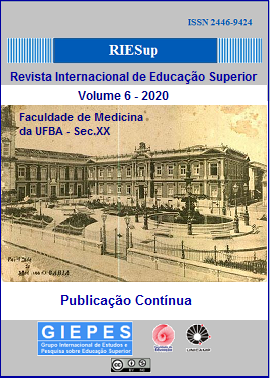Abstract
Reflecting on the education of deaf subjects in Higher Education, tells us to find possibilities with the use of assistive technologies. This bibliographic research seeks to analyze how the accessibility of the deaf subject has been regulated through Assistive Technology in Higher Education and which of these can reduce the communication barriers between deaf and hearing. It brings the main considerations in a reflection on the deaf community, seeking theoretical supports to characterize it. Also, we approach the evolution of technologies, making a reflection on their insertion in daily life, as well as the main regulations that support the care of the deaf subject and research on how the inclusion of deaf subjects in Teaching has been discussed. Higher Education and how HEIs can reduce the communication barriers between hearing subjects and deaf subjects. We conclude that assistive technologies are instruments capable of facilitating communication between the subjects and that, in order to include deaf subjects, we need to break through the physical, methodological and attitudinal barriers, aiming at constituting that the HEIs build a universal design in which everyone feel citizens with the same rights to express themselves and have access to the construction of professional and personal knowledge.
References
ADORNO, Theodor Wiesengrund. Educação e emancipação. 2. ed. São Paulo: Paz e Terra, 2000.
BETTS, D. N. Desafios para o docente do século XXI: o impacto das novas tecnologias de informação e comunicação. In: DANILUK, Ocsana Sônia. (Org).; QUEVEDO, Hercília Fraga de.; MATTOS, Mára Beatriz Pucci de. (Org.). Conhecimento sem fronteira. 1. ed. Passo Fundo: UPF Editora, 2005.
BRASIL. Decreto Federal nº 3.298, de 20 de dezembro de 1999. Regulamenta a Lei no 7.853, de 24 de outubro de 1989, dispõe sobre a Política Nacional para a Integração da Pessoa Portadora de Deficiência, consolida as normas de proteção, e dá outras providências. Brasília, 20 de dezembro de 1999. Disponível em: https://www.planalto.gov.br/ccivil_03/decreto/D3298.htm. Acesso em: 28 jul. 2017.
BRASIL. Lei nº 12.319, de 1º de setembro de 2010. Regulamenta a profissão de Tradutor e Intérprete da Língua Brasileira de Sinais – LIBRAS. Brasília, DF. Disponível em: http://www.planalto.gov.br/ccivil_03/_Ato2007-2010/2010/Lei/L12319.htm. Acesso em: 25 jul. 2017.
GALVÃO FILHO, Teófilo Alves. Tecnologia Assistiva para uma escola inclusiva: apropriação, demandas e perspectivas. 2009. 346 f. Tese (Doutorado em Educação) - Faculdade de Educação, UFBA, Salvador, 2009.
GIL, Antônio Carlos. Como elaborar projetos de pesquisa. 4. ed. São Paulo: Atlas, 2002.
GRINSPUN, Mirian Paura Sabrosa Zippin (Org). Educação tecnológica: desafios e perspectivas. São Paulo: 1999.
LÉVY, Pierre. Cibercultura. São Paulo: Editora 34, 1999.
MORAN, José Manuel. Novas tecnologias e mediação pedagógica. Campinas: Papirus, 2012.
MOROSINI, Marilia Costa. Enciclopédia de pedagogia universitária: glossário v. 2. Brasília: Instituto Nacional de Estudos e Pesquisas Educacionais Anísio Teixeira, 2006.
NOGARO, Arnaldo. CERUTTI, Elisabete. As TICs nos labirintos da prática educativa. Curitiba: CRV, 2016.
PERNISA JUNIOR, Carlos. VIANA, Fernanda. Interfaces do Saber: o uso das tecnologias digitais na difusão do conhecimento. Impulso, Piracicaba, SP, v. 20, n. 49, jan./jun. 2010.
PINTO, Marcianinha Aparecida. As novas tecnologias e a educação. 2004. Disponível em: http://www.portalanpedsul.com.br/admin/uploads/2004/Poster/Poster/04_53_48_AS_NOVAS_TECNOLOGIAS_E_A_EDUCACAO.pdf. Acesso em: 08 jun. 2017.
SANTAROSA, Lucila Maria Costi. “Escola virtual” para a educação especial: ambientes de aprendizagem telemáticos cooperativos como alternativa de desenvolvimento. Revista de Informática Educativa, Bogotá, Colômbia, v. 10, n. 1, p. 115-138, 1997.
STUMPF, Marianne Rossi. Mudanças estruturais para uma inclusão ética. In: QUADROS, Ronice Muller de. Estudos Surdos III. Petrópolis, RJ: Arara Azul, 2008. p. 14-29.
VALENTE, José Armando. As tecnologias digitais e os diferentes letramentos. Pátio Revista Pedagógica, Porto Alegre, v. 11, p. 12-15, 2007.
VALENTE, José Armando. As tecnologias e a verdadeira inovação. Ensino Fundamental, Pátio Revista Pedagógica, Porto Alegre, v. 14, p. 6-9, 2010.
VALENTINI, Carla Beatris. Inclusão no Ensino Superior: especificidades da prática docente com estudantes surdos. Caxias do Sul: Educar, 2012.
WAGNER, Geovane Cristina. LAZZERI, Cristiane. RAMOS, Fabiane dos Santos. Tecnologia assistiva: uma ferramenta para inclusão escolar. In: SILUK, Ana Cláudia Pavão. (Org.). Atendimento Educacional Especializado: Processos de Aprendizagem na Universidade. 1. ed. 1. Reimpr. Santa Maria: Laboratório de pesquisa e documentação – CE. Universidade de Santa Maria: UFSM, 2014.

This work is licensed under a Creative Commons Attribution 4.0 International License.
Copyright (c) 2020 Revista Internacional de Educação Superior


